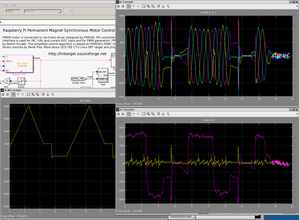 Raspberry Pi is often
used for education and many hobbyists tasks but it is not equipped with hardware
peripherals required for a quite complex vector electric motor control task.
This project sumplements bare Raspberry Pi board by two other boards to implement
complete educational BLDC/PMSM motor control system. One board uses small
Microsemi IGL00 FPGA to implement missing peripherals and the second board
implements 3-phase power stage with current sensing, ADC and galvanic
isolation which can be used in this project or even connected
to Altera DE2 education kits.
Raspberry Pi is often
used for education and many hobbyists tasks but it is not equipped with hardware
peripherals required for a quite complex vector electric motor control task.
This project sumplements bare Raspberry Pi board by two other boards to implement
complete educational BLDC/PMSM motor control system. One board uses small
Microsemi IGL00 FPGA to implement missing peripherals and the second board
implements 3-phase power stage with current sensing, ADC and galvanic
isolation which can be used in this project or even connected
to Altera DE2 education kits.
Three-pases PMSM Control Basics
The differences between Voltages connected to the three stator windings
terminals cause current flow which forms rotating magnetic field.
The direction and magnitude of this field drive permanent magnet
rotor which is to align with the direction of the magnetic field vector.
North pole is attracted to the south and vice versa. For constant speed
and torque, the waveforms of the phase Voltages (the same for currents)
are sinusoidal with an equidistant phase shift of 120 deg. The three phases
system is in some respect redundant, in the case of Voltages (uA,
uB, uC) only differences count, i.e. one can be
fixed to zero. A sum of the three currents (iA, iB,
iC) has to be zero by the Kirchhoff's current law. As a consequence,
only two independent quantities/scalars are needed to describe the currents
or Voltages which are in the fact vector in the 2D space.The polar coordinates
system can be used but a rectangular system of alpha, beta components is equivalent
and easier for transformations computation.
 This transformation of the three phase
system to the two orthogonal components vector is named according to its
inventor Clark transformation. The waveforms in this 2D system are sine
and cosine for steady speed state. Because realization of a controller
in this altering components system is not feasible, another transformation
was invented which convert the quantities to the coordinates fixed to
the revolving rotor. A base formed by direct (D) component aligned to North,
South pole direction of the rotor and orthogonal quadrature (Q) has been
introduced by Robert H. Park and the transformation is named according to him.
The control in the D-Q coordinates is (almost) independent of actual rotor
position and (in simplified outlook) separates reactive current (iD)
from the active current (iQ) resulting in torque affecting rotor
movement. The simplified diagram of PMSM motor control ins included for ilustration
(source PXMC library documentation).
This transformation of the three phase
system to the two orthogonal components vector is named according to its
inventor Clark transformation. The waveforms in this 2D system are sine
and cosine for steady speed state. Because realization of a controller
in this altering components system is not feasible, another transformation
was invented which convert the quantities to the coordinates fixed to
the revolving rotor. A base formed by direct (D) component aligned to North,
South pole direction of the rotor and orthogonal quadrature (Q) has been
introduced by Robert H. Park and the transformation is named according to him.
The control in the D-Q coordinates is (almost) independent of actual rotor
position and (in simplified outlook) separates reactive current (iD)
from the active current (iQ) resulting in torque affecting rotor
movement. The simplified diagram of PMSM motor control ins included for ilustration
(source PXMC library documentation).
Hardware
The RPi (and its BCM2835 SoC) is equipped with only single accessible PWM output and no peripherals suitable for incremental rotary encoder (IRC) signal processing are found on the board. Analog to digital converters are missing as well. The two extension boards with required peripherals and power stage have been designed and produced at PiKRON company. The first one includes Field Programmable Gate Array (FPGA) IGLOO AGL125-VQ100 produced by Microsemi company. The design of logic programmed into FPGA has been implemented by Martin Prudek in a frame of his bachelor theses. The FPGA design includes:
- SPI interface which connect peripherals to RPi board
- 32-bit qudrate encoder (IRC) position counter based on design of Marek Peca's ( quadcount)
- three PWM outputs with half-bridge enable enable signals
- finite state automata for acquiring current measuremts from analog to digital converter and filtering/decimation of multiple fast reads for slower RPi processing
Links
- Processor Systems, GNU/Linux and Control Applications, LinuxDays, 2016
-
- Available online in PDF format
The second part of the presentation is focused on PMSM motors control lab example. - Available online in PDF format
- Bachelor thesis of Martin Prudek: Brushless motor control with Raspberry Pi board and Linux, 2015
- Available online in PDF format
The FPGA design of peripherals for the RPi expansion board https://rtime.felk.cvut.cz/gitweb/fpga/rpi-motor-control.git - PMSM Control Simulink Model including PRi Hardware and SPI Communication Blocks
- https://github.com/ppisa/rpi-rt-control
The model and bclocks C sources are included in subdirectory "simulink", model name "rpi_pmsm_motor_control.slx". - Fully preemptive kernel sources for RPi (kernel-3.12.28-rt40+)
- https://github.com/ppisa/linux-rpi
GitHub repository with branch rpi-3.18.y-aufs-rt-ppisa containing Linux kernel sources with Steven Rostedt's stable preempt_rt (patch-3.18.16-rt13) and with Junjiro R. Okajima's aufs3.18.x 20160215 patches applied. - Simulink Embedded Coder target for Linux
- http://rtime.felk.cvut.cz/gitweb/ert_linux.git
Repository with core templates for Linux hosted, Linux cross architecture targetted Simulink code generation templates and configuration. - Auxiliary utilities for Raspberry Pi
- https://github.com/ppisa/rpi-utils
The repository includes RAM based root overlay support to protect SDcard against wearing and tearing and keep root filesystem intact when experiments are download and run on system or even crash it.